
Spain and Morocco 1999
Page 3
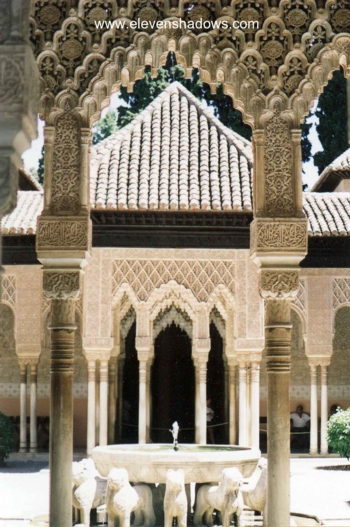 Alhambra
in Granada, built by the Muslims. Alhambra
in Granada, built by the Muslims. |
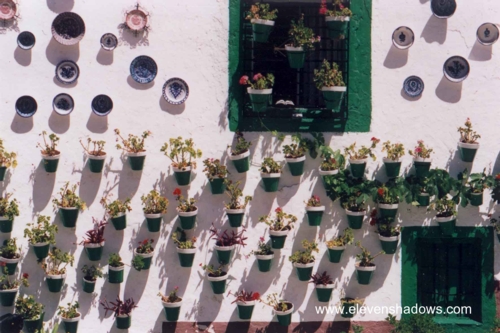 The next day, Keiko had to return
back to Italy, although she went by way of the beach, while I decided to explore more of
Granada. The next day, Keiko had to return
back to Italy, although she went by way of the beach, while I decided to explore more of
Granada.
~~ This is on a path east of the barrio of Sacro Monte, which is known for its flamenco playing and late-night flamenco cafes. There were also a few flamenco schools located in Sacro Monte. |
| North to Toledo I saw quite a lot of Granada, walking around the barrios of Sacro Monte and Albaicin, visiting the very large cathedral and various other sites, and eating some delicious food along the way. I then caught a bus at 11:00 p.m. to Madrid, and then a connecting bus to Toledo, which is in the middle of the country. Yes, this was once again doing the time-honored tradition of using a bus as a hotel, the third such time in this trip, and the second time in Spain. |
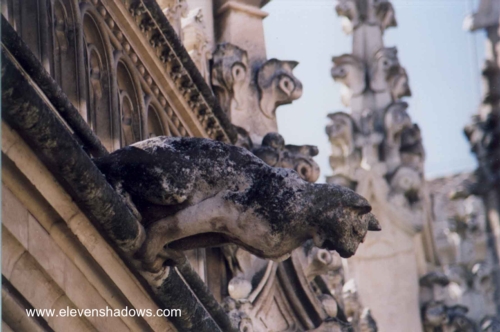 This is the Monasterio de San Juan de los Reyes in Toledo, which has
distinctly Gothic touches in its architecture. I felt that Toledo was a very
charming city, with its lovely medieval stone buildings and cobblestone streets perched on
a large mound-shaped hill with the Río Tajo circling around the walled part of the city
in such a manner that over 2/3 of the city is surrounded by the river. This is the Monasterio de San Juan de los Reyes in Toledo, which has
distinctly Gothic touches in its architecture. I felt that Toledo was a very
charming city, with its lovely medieval stone buildings and cobblestone streets perched on
a large mound-shaped hill with the Río Tajo circling around the walled part of the city
in such a manner that over 2/3 of the city is surrounded by the river.
|
| East to Cuenca I took a bus going east for about 2.5-3 hours to the small town of Cuenca, a medieval town that is built on a fairly large set of cliffs. I stayed at the Pension Marín, which has to be about the darkest, dingiest place I have ever stayed at, although it was clean. The old town of Cuenca was very charming and small. The cathedral was built and rebuilt, and exhibited these different sorts of influences in an interesting manner, notably the modern stain-glassed windows, made by the Workshop-School of Cuenca Alta-Cooperativa Vitrea. |
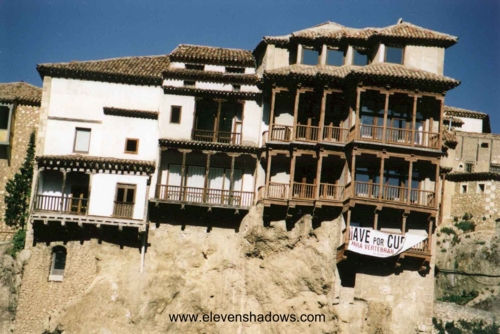 Cuenca's landmark Casas Colgadas (Hanging
Houses). The facades overhang the Huécar Gorge. They date back to the 14th
century, when many houses like this extended along the banks of the river. Only
these three houses remain today, two occupied by the stunning Museo de Arte Abstracto
Español and the other by a restaurant. Cuenca's landmark Casas Colgadas (Hanging
Houses). The facades overhang the Huécar Gorge. They date back to the 14th
century, when many houses like this extended along the banks of the river. Only
these three houses remain today, two occupied by the stunning Museo de Arte Abstracto
Español and the other by a restaurant. |
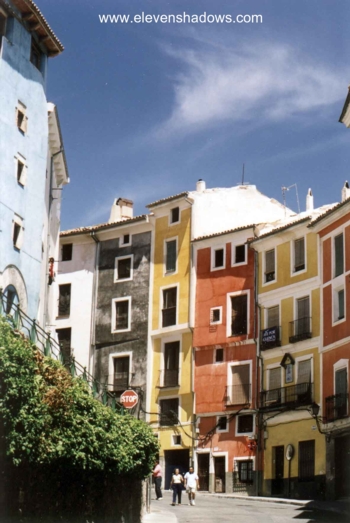 Calle Alfonso VIII, just south of the main Plaza in Cuenca,
Spain. This is the most beautiful street that I saw while traveling in Spain. Calle Alfonso VIII, just south of the main Plaza in Cuenca,
Spain. This is the most beautiful street that I saw while traveling in Spain.Due to the lack of flexibility in the bus schedule, I had to spend an entire day traveling from Cuenca to my next destination, Sevilla. Including all the changes of buses, it took from 8:00 in the morning until 11:30 p.m. to get to Sevilla. I still managed to get a hostel at that late hour. After a very badly-needed shower, I treated myself to a sinful amount of ice cream at the local heladeria. |
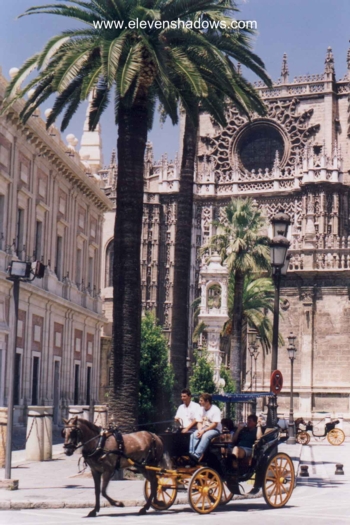 The next day in Sevilla, I explored one of the largest
cathedrals in all of Europe. The next day in Sevilla, I explored one of the largest
cathedrals in all of Europe. |
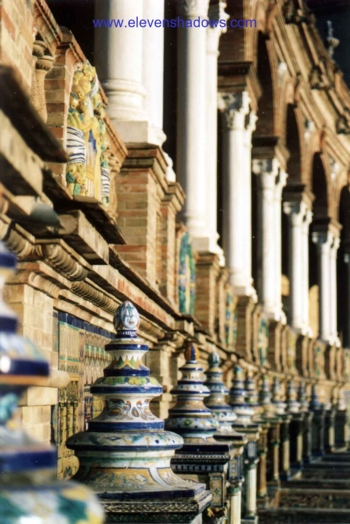 Plaza De España in Sevilla. Plaza De España in Sevilla.
|
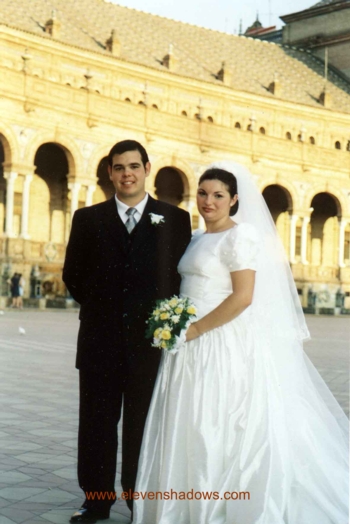 Plaza de España. Not the most
jubilant wedding couple I've ever seen, although it's quite possible that the intense
Spanish heat was sapping their enthusiasm. Or maybe they were thinking, "Who is
this guy, and why is he taking our picture?" Plaza de España. Not the most
jubilant wedding couple I've ever seen, although it's quite possible that the intense
Spanish heat was sapping their enthusiasm. Or maybe they were thinking, "Who is
this guy, and why is he taking our picture?" |
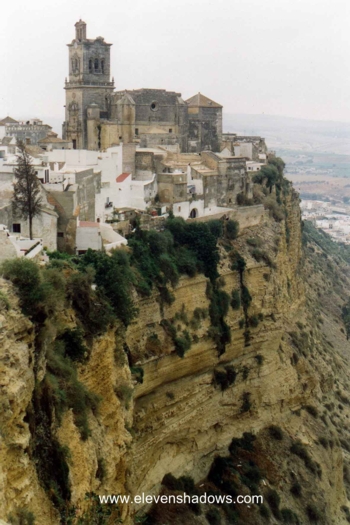 The following day, I took a short bus trip southward to the lovely little
town of Arcos de la Frontera. This is of course another small town that is perched
up on sheer cliffs. The following day, I took a short bus trip southward to the lovely little
town of Arcos de la Frontera. This is of course another small town that is perched
up on sheer cliffs. I actually saw this town from the bus that was going from Ronda to Cádiz, and thought that it deserved a better look. It was a beautiful, charming town, and I ended up staying for a couple of days, walking around the town, eating paella at the cafes, and chatting up the locals. One of the locals, an Irishman, was busy refurbishing a two-century year old home into a very refreshing new house, full of air and beauty, but took a few hours to describe what he was doing. |
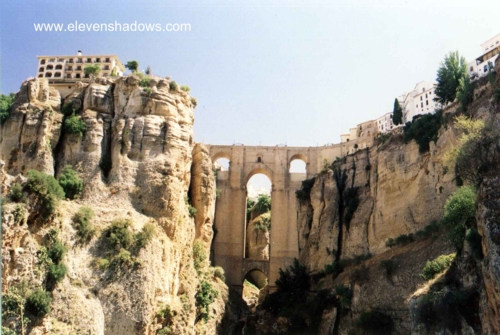 I had to take a bus to Ronda to get to the
south. Since I was in Ronda anyway, I decided to spend one more day there. The
people working at Hostel Biarritz gave me a hearty welcome back. I had to take a bus to Ronda to get to the
south. Since I was in Ronda anyway, I decided to spend one more day there. The
people working at Hostel Biarritz gave me a hearty welcome back.
I decided to hike down to the bottom, where a small town was located. This is the view from the small village just below Ronda, looking up at the Puente Nuevo, or New Bridge, which connects the town from the gaping gorge that Río Guadalevin has created. A while back, the center of the bridge just above the central arch was used as a prison. |
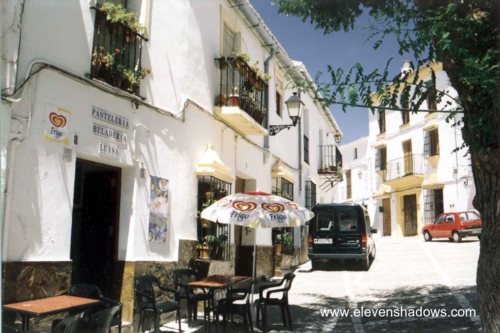 Calle Espiritu Santo, looking up towards the Iglesia del
Espiritu Santo, which was constructed in 1505. Calle Espiritu Santo, looking up towards the Iglesia del
Espiritu Santo, which was constructed in 1505. |
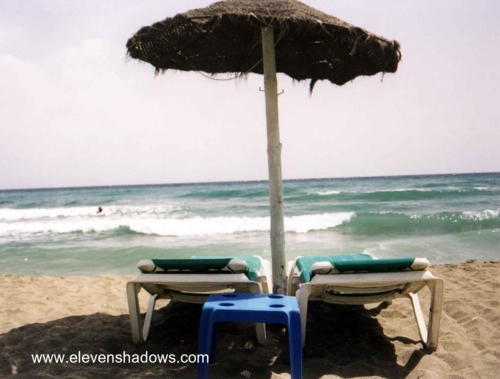 The
next day, I traveled by bus to Marbella, which is on the Costa del Sol on
the Mediterranean Coast. Marbella and the entire Costa del Sol is one
huge stretch of nice but crowded beaches, hotels, restaurants, gift shops,
and other hallmarks of tourism literally all the way down the coast to
Algeciras and beyond. Still, after the very hot, humid hikes in Ronda,
a day at the beach was quite relaxing. I was also quite excited about
my first dip into the Mediterranean. The
next day, I traveled by bus to Marbella, which is on the Costa del Sol on
the Mediterranean Coast. Marbella and the entire Costa del Sol is one
huge stretch of nice but crowded beaches, hotels, restaurants, gift shops,
and other hallmarks of tourism literally all the way down the coast to
Algeciras and beyond. Still, after the very hot, humid hikes in Ronda,
a day at the beach was quite relaxing. I was also quite excited about
my first dip into the Mediterranean. |
| Back to Morocco Then, hopping on a late bus to Algeciras from Marbella, and then catching a 10:00 p.m. ferry from Algeciras to Tangier, I made it to Morocco very late at night. The ferry ride was about two and a half hours long. A Polish couple who had caught the same late ferry with me and I were hopeful that we would avoid the crush of guides and other "helpful" sorts by our late-night arrival. Our hopes were dashed upon, as were set upon immediately. Tangier is still crawling with these sorts even late at night, and we were not left alone for a second despite our protests. My conversation with them sometimes went like this: "Let me show you a hotel." I would reply, "No, I don't need your help. I can see five hotels from here." Or someone would walk in front of us on the way to the hotel that we were walking to anyway and then claim that he had led us there and would ask for some dirhams. Nevertheless, we managed to bypass them and get a hotel. The next morning, after a brief wandering around the Petit Socco, where William Burroughs wrote some of his novels and was offered little boys and everything else, I walked up to the Kasbah, snooped around, then caught a southbound bus to Larache. |
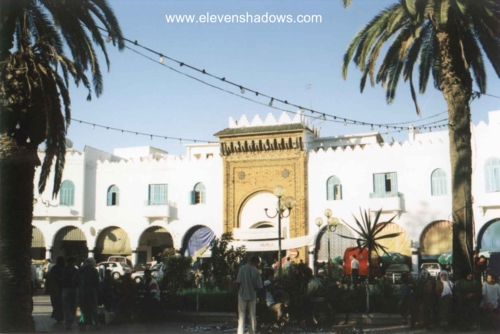 Larache is a small beach town located south of
Asilah and north of Rabat along the Atlantic Coast. I found it relaxing, peaceful,
and zween bizzaf ("very beautiful" in Moroccan Arabic). It was a
pleasure to stroll the very tiny medina, and the people were very friendly, a beautiful
contrast to the pushiness of Tangier. Larache is a small beach town located south of
Asilah and north of Rabat along the Atlantic Coast. I found it relaxing, peaceful,
and zween bizzaf ("very beautiful" in Moroccan Arabic). It was a
pleasure to stroll the very tiny medina, and the people were very friendly, a beautiful
contrast to the pushiness of Tangier.
Shown here is the Place de la Libération, a central hub of activity in Larache. People in Larache frequently come out for the evening stroll either here or in the promenade overlooking the Atlantic Ocean. |
| Larache Here in Larache, I could go swimming at the beach, not get hassled in the medina, eat spaghetti, tagines, paella or churros (Spanish deep-fried straight donuts) in airy seaside cafes while listening to gnawa music, get freshly squeezed orange juice for 3 dirham (US$.30), communicate in Spanish or even English instead of my 40-word Arabic vocabulary or my horrid French, and meet really nice people. I could get used to this! I met five very charming Germans and a Moroccan acrobat named Said. We went to the beach and cafes together, and even explored the Roman ruins of Lixus about 5km north of Larache. |
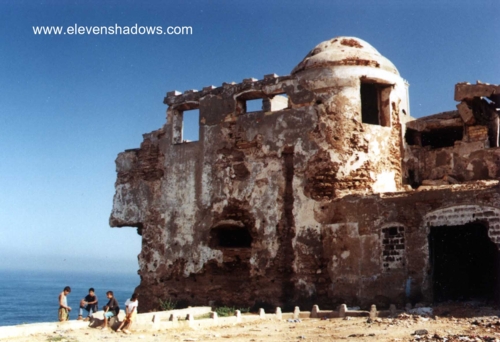 Fortress ruins in Larache. The ruined kasbah, the
Qebibat, was constructed by the Portuguese in the 16th Century. This is located at
the end of the surrealistic multi-colored medina. Fortress ruins in Larache. The ruined kasbah, the
Qebibat, was constructed by the Portuguese in the 16th Century. This is located at
the end of the surrealistic multi-colored medina. |
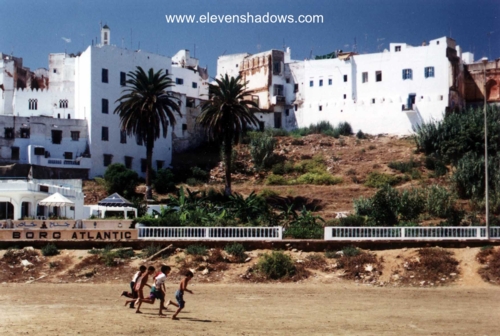 Larache, looking up at the medina from the
shoreline. Larache, looking up at the medina from the
shoreline. |
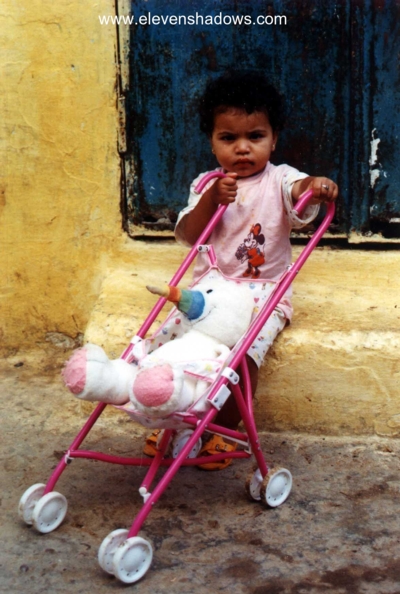 Inside the medina in Larache! Inside the medina in Larache! |
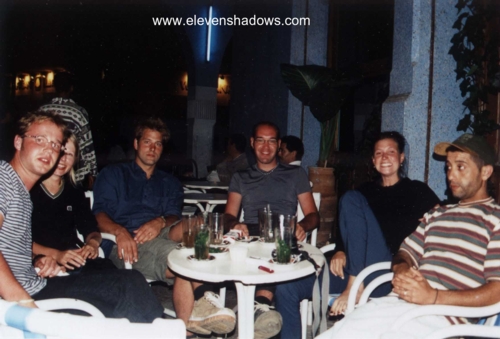 I had the pleasure of hanging out with these very cool people from Germany
(Tobias, Veronika, Arndt, and Doro) and a Moroccan local named Said, an acrobat who tours
Europe. I had the pleasure of hanging out with these very cool people from Germany
(Tobias, Veronika, Arndt, and Doro) and a Moroccan local named Said, an acrobat who tours
Europe. |
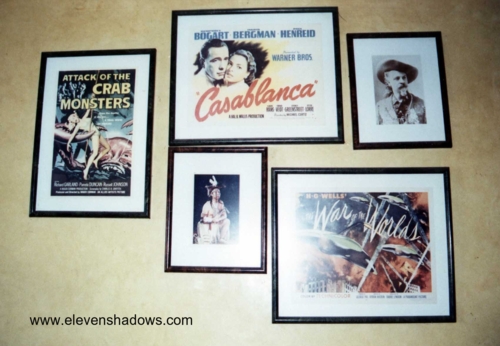 All the cinematic heavyweights are displayed here in this
Casablanca pizzeria -- "Casablanca" and "Attack of the Crab Monsters"! All the cinematic heavyweights are displayed here in this
Casablanca pizzeria -- "Casablanca" and "Attack of the Crab Monsters"! |
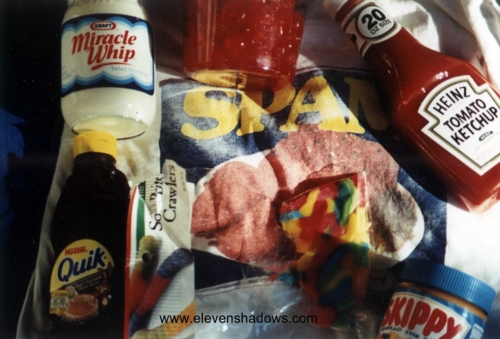 While eating fresh, delicious, carefully
prepared exotic cuisine is all fine and good, isn't this what we really crave, deep down
inside? While eating fresh, delicious, carefully
prepared exotic cuisine is all fine and good, isn't this what we really crave, deep down
inside?Naahhhh, me either. |
Spain and Morocco 1999
Page 3
Morocco and Spain Home Page
Eleven Shadows Travel Page
Contact photographer/musician Ken Lee